Singleton's Management Strategy: Business Development Report
VerifiedAdded on 2021/06/14
|9
|2435
|116
Report
AI Summary
This report provides a comprehensive analysis of Singleton, a company specializing in battery manufacturing for electric golf carts and wheelchairs. It examines Singleton's business situation, competitive advantages, and challenges, including reduced sales in the golf cart market and production limitations. The report delves into Singleton's strategic plan to adopt new lithium technology, increasing capacity and reducing labor costs. It explores core competencies, process positioning, product technology, and process choice, highlighting the importance of focused manufacturing and the experience curve. The report also addresses capacity strategies and the potential benefits of focused manufacturing, emphasizing the need for Singleton to choose a solution that guarantees increased production of standard batteries at a reduced cost, with the new technology and focused manufacturing being key recommendations. The analysis covers a range of business development concepts including strategic planning, market analysis, and operational efficiency.
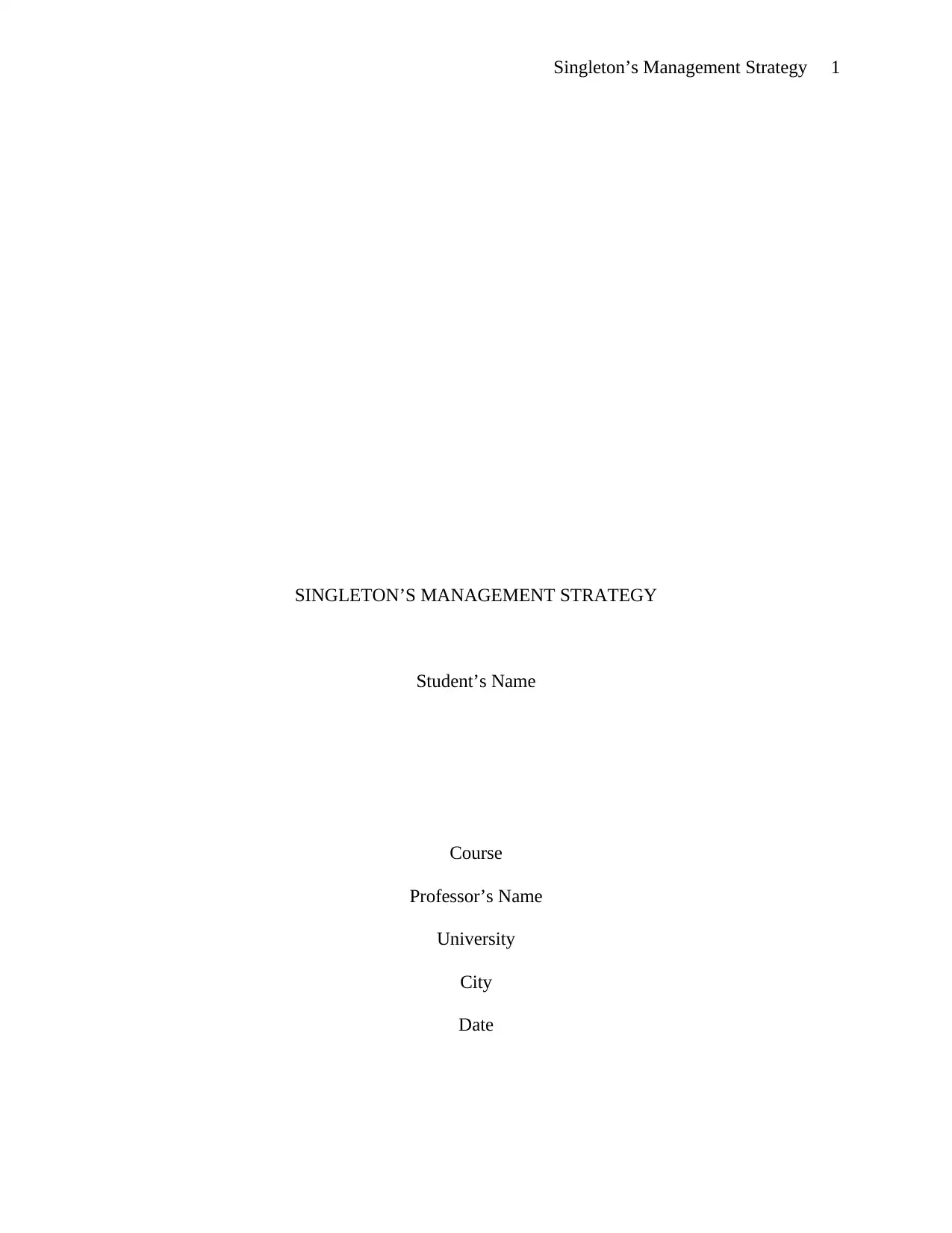
Singleton’s Management Strategy 1
SINGLETON’S MANAGEMENT STRATEGY
Student’s Name
Course
Professor’s Name
University
City
Date
SINGLETON’S MANAGEMENT STRATEGY
Student’s Name
Course
Professor’s Name
University
City
Date
Paraphrase This Document
Need a fresh take? Get an instant paraphrase of this document with our AI Paraphraser
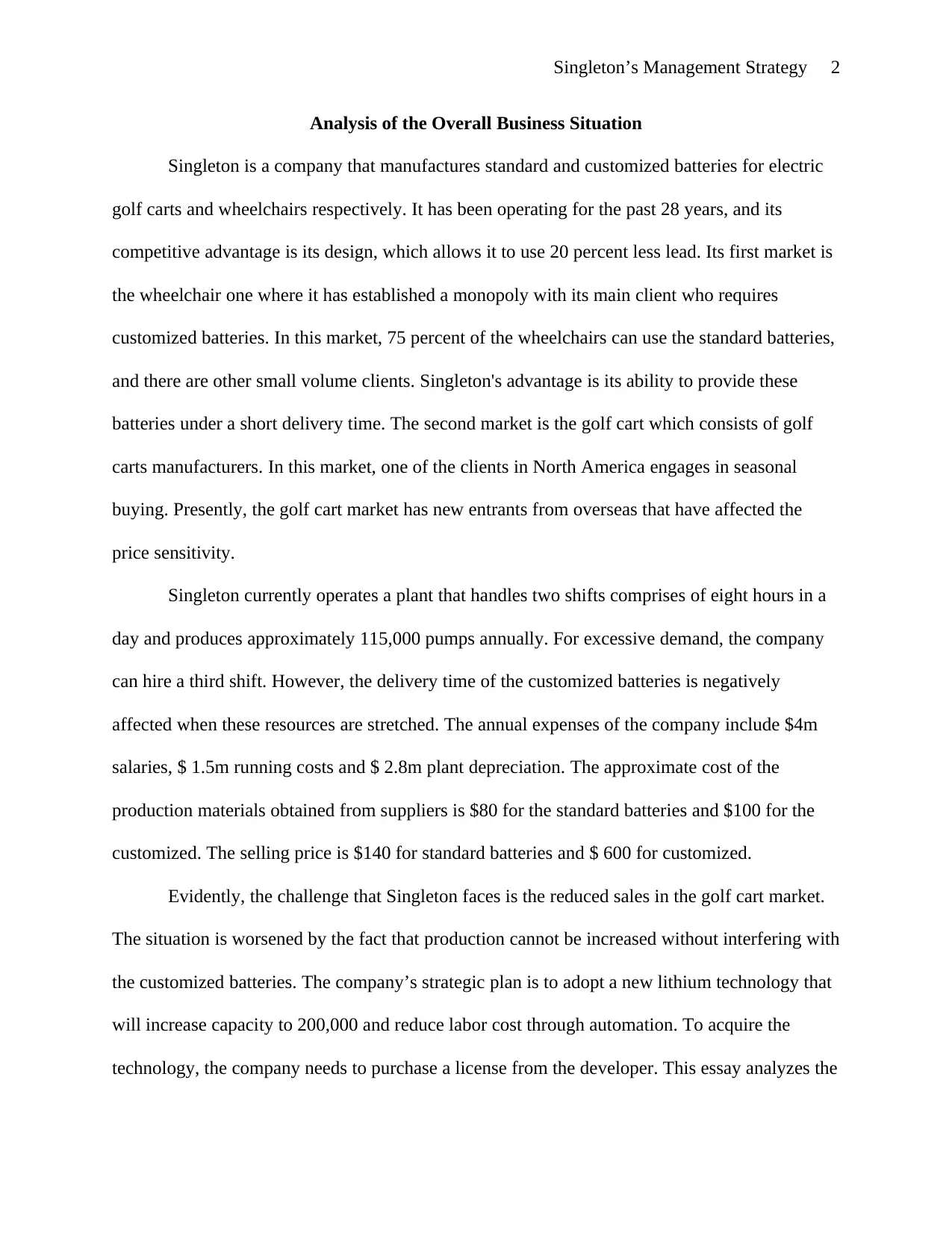
Singleton’s Management Strategy 2
Analysis of the Overall Business Situation
Singleton is a company that manufactures standard and customized batteries for electric
golf carts and wheelchairs respectively. It has been operating for the past 28 years, and its
competitive advantage is its design, which allows it to use 20 percent less lead. Its first market is
the wheelchair one where it has established a monopoly with its main client who requires
customized batteries. In this market, 75 percent of the wheelchairs can use the standard batteries,
and there are other small volume clients. Singleton's advantage is its ability to provide these
batteries under a short delivery time. The second market is the golf cart which consists of golf
carts manufacturers. In this market, one of the clients in North America engages in seasonal
buying. Presently, the golf cart market has new entrants from overseas that have affected the
price sensitivity.
Singleton currently operates a plant that handles two shifts comprises of eight hours in a
day and produces approximately 115,000 pumps annually. For excessive demand, the company
can hire a third shift. However, the delivery time of the customized batteries is negatively
affected when these resources are stretched. The annual expenses of the company include $4m
salaries, $ 1.5m running costs and $ 2.8m plant depreciation. The approximate cost of the
production materials obtained from suppliers is $80 for the standard batteries and $100 for the
customized. The selling price is $140 for standard batteries and $ 600 for customized.
Evidently, the challenge that Singleton faces is the reduced sales in the golf cart market.
The situation is worsened by the fact that production cannot be increased without interfering with
the customized batteries. The company’s strategic plan is to adopt a new lithium technology that
will increase capacity to 200,000 and reduce labor cost through automation. To acquire the
technology, the company needs to purchase a license from the developer. This essay analyzes the
Analysis of the Overall Business Situation
Singleton is a company that manufactures standard and customized batteries for electric
golf carts and wheelchairs respectively. It has been operating for the past 28 years, and its
competitive advantage is its design, which allows it to use 20 percent less lead. Its first market is
the wheelchair one where it has established a monopoly with its main client who requires
customized batteries. In this market, 75 percent of the wheelchairs can use the standard batteries,
and there are other small volume clients. Singleton's advantage is its ability to provide these
batteries under a short delivery time. The second market is the golf cart which consists of golf
carts manufacturers. In this market, one of the clients in North America engages in seasonal
buying. Presently, the golf cart market has new entrants from overseas that have affected the
price sensitivity.
Singleton currently operates a plant that handles two shifts comprises of eight hours in a
day and produces approximately 115,000 pumps annually. For excessive demand, the company
can hire a third shift. However, the delivery time of the customized batteries is negatively
affected when these resources are stretched. The annual expenses of the company include $4m
salaries, $ 1.5m running costs and $ 2.8m plant depreciation. The approximate cost of the
production materials obtained from suppliers is $80 for the standard batteries and $100 for the
customized. The selling price is $140 for standard batteries and $ 600 for customized.
Evidently, the challenge that Singleton faces is the reduced sales in the golf cart market.
The situation is worsened by the fact that production cannot be increased without interfering with
the customized batteries. The company’s strategic plan is to adopt a new lithium technology that
will increase capacity to 200,000 and reduce labor cost through automation. To acquire the
technology, the company needs to purchase a license from the developer. This essay analyzes the
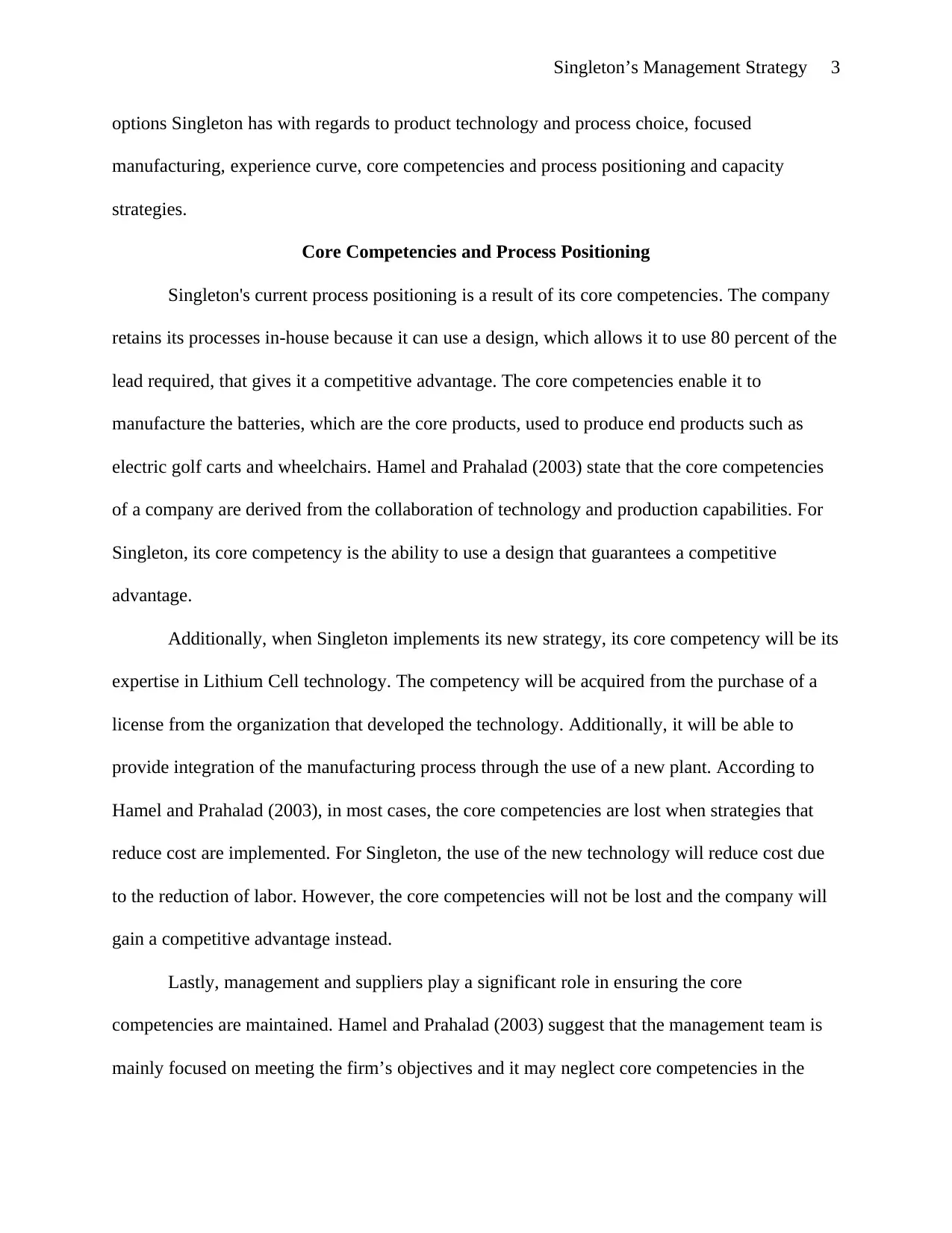
Singleton’s Management Strategy 3
options Singleton has with regards to product technology and process choice, focused
manufacturing, experience curve, core competencies and process positioning and capacity
strategies.
Core Competencies and Process Positioning
Singleton's current process positioning is a result of its core competencies. The company
retains its processes in-house because it can use a design, which allows it to use 80 percent of the
lead required, that gives it a competitive advantage. The core competencies enable it to
manufacture the batteries, which are the core products, used to produce end products such as
electric golf carts and wheelchairs. Hamel and Prahalad (2003) state that the core competencies
of a company are derived from the collaboration of technology and production capabilities. For
Singleton, its core competency is the ability to use a design that guarantees a competitive
advantage.
Additionally, when Singleton implements its new strategy, its core competency will be its
expertise in Lithium Cell technology. The competency will be acquired from the purchase of a
license from the organization that developed the technology. Additionally, it will be able to
provide integration of the manufacturing process through the use of a new plant. According to
Hamel and Prahalad (2003), in most cases, the core competencies are lost when strategies that
reduce cost are implemented. For Singleton, the use of the new technology will reduce cost due
to the reduction of labor. However, the core competencies will not be lost and the company will
gain a competitive advantage instead.
Lastly, management and suppliers play a significant role in ensuring the core
competencies are maintained. Hamel and Prahalad (2003) suggest that the management team is
mainly focused on meeting the firm’s objectives and it may neglect core competencies in the
options Singleton has with regards to product technology and process choice, focused
manufacturing, experience curve, core competencies and process positioning and capacity
strategies.
Core Competencies and Process Positioning
Singleton's current process positioning is a result of its core competencies. The company
retains its processes in-house because it can use a design, which allows it to use 80 percent of the
lead required, that gives it a competitive advantage. The core competencies enable it to
manufacture the batteries, which are the core products, used to produce end products such as
electric golf carts and wheelchairs. Hamel and Prahalad (2003) state that the core competencies
of a company are derived from the collaboration of technology and production capabilities. For
Singleton, its core competency is the ability to use a design that guarantees a competitive
advantage.
Additionally, when Singleton implements its new strategy, its core competency will be its
expertise in Lithium Cell technology. The competency will be acquired from the purchase of a
license from the organization that developed the technology. Additionally, it will be able to
provide integration of the manufacturing process through the use of a new plant. According to
Hamel and Prahalad (2003), in most cases, the core competencies are lost when strategies that
reduce cost are implemented. For Singleton, the use of the new technology will reduce cost due
to the reduction of labor. However, the core competencies will not be lost and the company will
gain a competitive advantage instead.
Lastly, management and suppliers play a significant role in ensuring the core
competencies are maintained. Hamel and Prahalad (2003) suggest that the management team is
mainly focused on meeting the firm’s objectives and it may neglect core competencies in the
⊘ This is a preview!⊘
Do you want full access?
Subscribe today to unlock all pages.

Trusted by 1+ million students worldwide
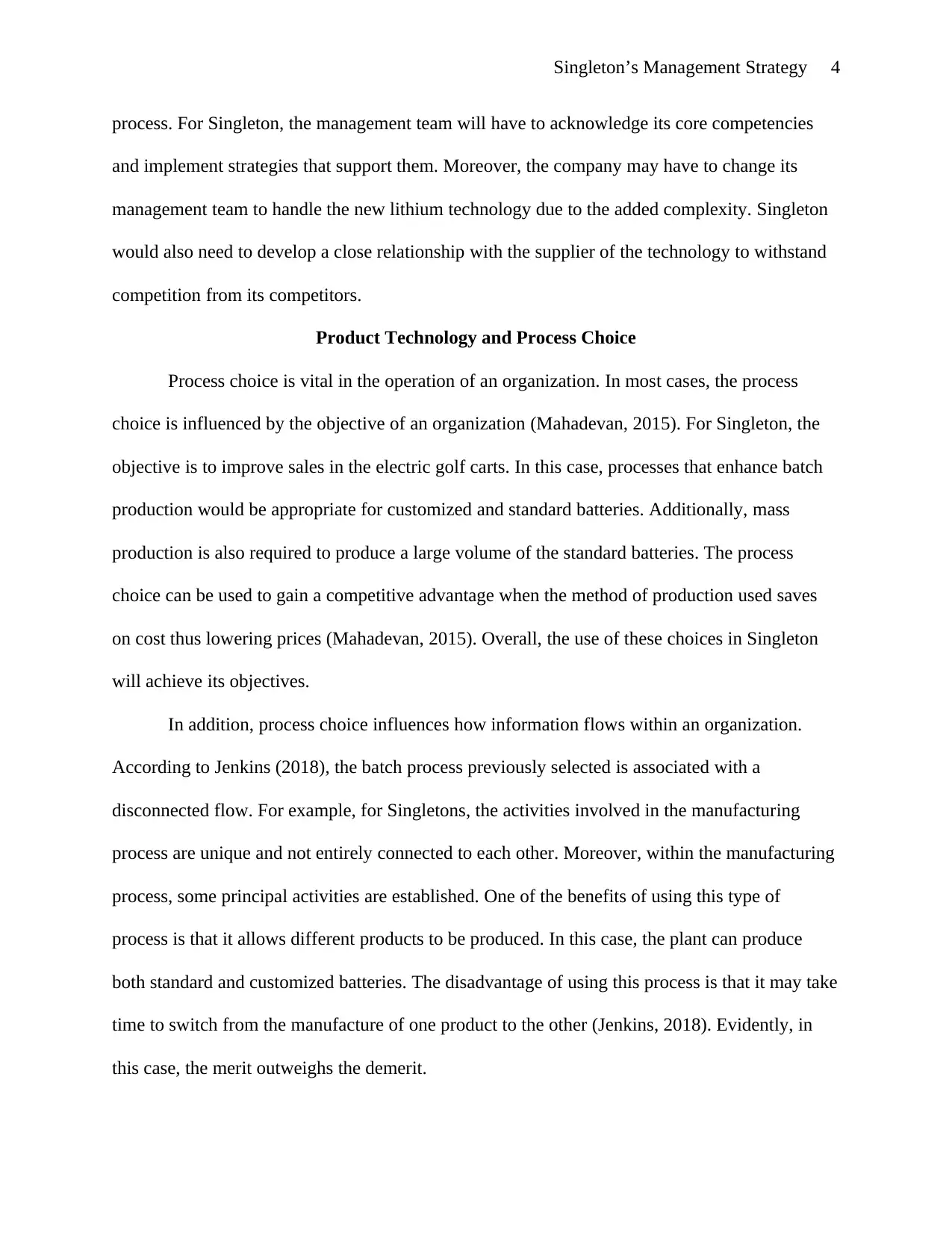
Singleton’s Management Strategy 4
process. For Singleton, the management team will have to acknowledge its core competencies
and implement strategies that support them. Moreover, the company may have to change its
management team to handle the new lithium technology due to the added complexity. Singleton
would also need to develop a close relationship with the supplier of the technology to withstand
competition from its competitors.
Product Technology and Process Choice
Process choice is vital in the operation of an organization. In most cases, the process
choice is influenced by the objective of an organization (Mahadevan, 2015). For Singleton, the
objective is to improve sales in the electric golf carts. In this case, processes that enhance batch
production would be appropriate for customized and standard batteries. Additionally, mass
production is also required to produce a large volume of the standard batteries. The process
choice can be used to gain a competitive advantage when the method of production used saves
on cost thus lowering prices (Mahadevan, 2015). Overall, the use of these choices in Singleton
will achieve its objectives.
In addition, process choice influences how information flows within an organization.
According to Jenkins (2018), the batch process previously selected is associated with a
disconnected flow. For example, for Singletons, the activities involved in the manufacturing
process are unique and not entirely connected to each other. Moreover, within the manufacturing
process, some principal activities are established. One of the benefits of using this type of
process is that it allows different products to be produced. In this case, the plant can produce
both standard and customized batteries. The disadvantage of using this process is that it may take
time to switch from the manufacture of one product to the other (Jenkins, 2018). Evidently, in
this case, the merit outweighs the demerit.
process. For Singleton, the management team will have to acknowledge its core competencies
and implement strategies that support them. Moreover, the company may have to change its
management team to handle the new lithium technology due to the added complexity. Singleton
would also need to develop a close relationship with the supplier of the technology to withstand
competition from its competitors.
Product Technology and Process Choice
Process choice is vital in the operation of an organization. In most cases, the process
choice is influenced by the objective of an organization (Mahadevan, 2015). For Singleton, the
objective is to improve sales in the electric golf carts. In this case, processes that enhance batch
production would be appropriate for customized and standard batteries. Additionally, mass
production is also required to produce a large volume of the standard batteries. The process
choice can be used to gain a competitive advantage when the method of production used saves
on cost thus lowering prices (Mahadevan, 2015). Overall, the use of these choices in Singleton
will achieve its objectives.
In addition, process choice influences how information flows within an organization.
According to Jenkins (2018), the batch process previously selected is associated with a
disconnected flow. For example, for Singletons, the activities involved in the manufacturing
process are unique and not entirely connected to each other. Moreover, within the manufacturing
process, some principal activities are established. One of the benefits of using this type of
process is that it allows different products to be produced. In this case, the plant can produce
both standard and customized batteries. The disadvantage of using this process is that it may take
time to switch from the manufacture of one product to the other (Jenkins, 2018). Evidently, in
this case, the merit outweighs the demerit.
Paraphrase This Document
Need a fresh take? Get an instant paraphrase of this document with our AI Paraphraser
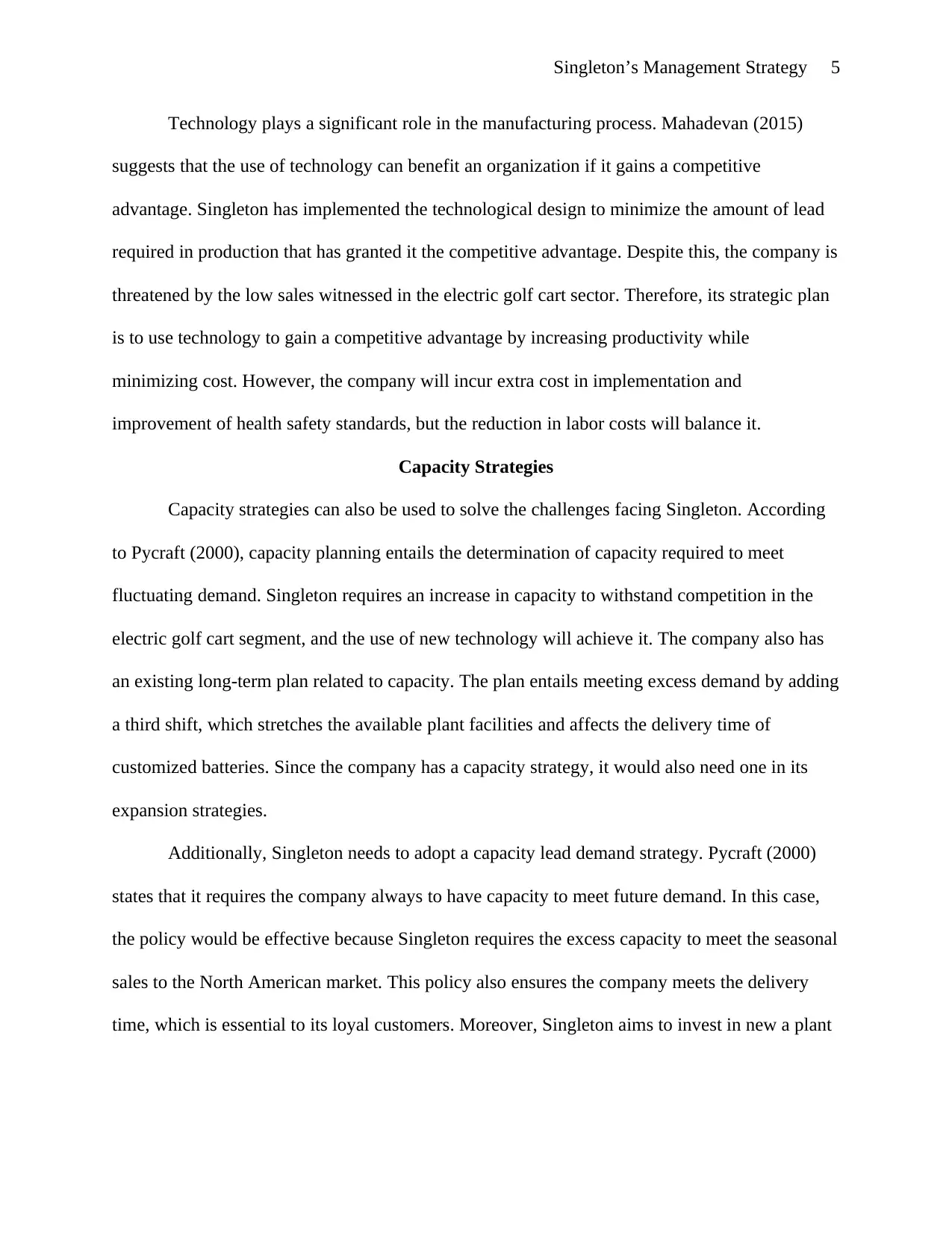
Singleton’s Management Strategy 5
Technology plays a significant role in the manufacturing process. Mahadevan (2015)
suggests that the use of technology can benefit an organization if it gains a competitive
advantage. Singleton has implemented the technological design to minimize the amount of lead
required in production that has granted it the competitive advantage. Despite this, the company is
threatened by the low sales witnessed in the electric golf cart sector. Therefore, its strategic plan
is to use technology to gain a competitive advantage by increasing productivity while
minimizing cost. However, the company will incur extra cost in implementation and
improvement of health safety standards, but the reduction in labor costs will balance it.
Capacity Strategies
Capacity strategies can also be used to solve the challenges facing Singleton. According
to Pycraft (2000), capacity planning entails the determination of capacity required to meet
fluctuating demand. Singleton requires an increase in capacity to withstand competition in the
electric golf cart segment, and the use of new technology will achieve it. The company also has
an existing long-term plan related to capacity. The plan entails meeting excess demand by adding
a third shift, which stretches the available plant facilities and affects the delivery time of
customized batteries. Since the company has a capacity strategy, it would also need one in its
expansion strategies.
Additionally, Singleton needs to adopt a capacity lead demand strategy. Pycraft (2000)
states that it requires the company always to have capacity to meet future demand. In this case,
the policy would be effective because Singleton requires the excess capacity to meet the seasonal
sales to the North American market. This policy also ensures the company meets the delivery
time, which is essential to its loyal customers. Moreover, Singleton aims to invest in new a plant
Technology plays a significant role in the manufacturing process. Mahadevan (2015)
suggests that the use of technology can benefit an organization if it gains a competitive
advantage. Singleton has implemented the technological design to minimize the amount of lead
required in production that has granted it the competitive advantage. Despite this, the company is
threatened by the low sales witnessed in the electric golf cart sector. Therefore, its strategic plan
is to use technology to gain a competitive advantage by increasing productivity while
minimizing cost. However, the company will incur extra cost in implementation and
improvement of health safety standards, but the reduction in labor costs will balance it.
Capacity Strategies
Capacity strategies can also be used to solve the challenges facing Singleton. According
to Pycraft (2000), capacity planning entails the determination of capacity required to meet
fluctuating demand. Singleton requires an increase in capacity to withstand competition in the
electric golf cart segment, and the use of new technology will achieve it. The company also has
an existing long-term plan related to capacity. The plan entails meeting excess demand by adding
a third shift, which stretches the available plant facilities and affects the delivery time of
customized batteries. Since the company has a capacity strategy, it would also need one in its
expansion strategies.
Additionally, Singleton needs to adopt a capacity lead demand strategy. Pycraft (2000)
states that it requires the company always to have capacity to meet future demand. In this case,
the policy would be effective because Singleton requires the excess capacity to meet the seasonal
sales to the North American market. This policy also ensures the company meets the delivery
time, which is essential to its loyal customers. Moreover, Singleton aims to invest in new a plant
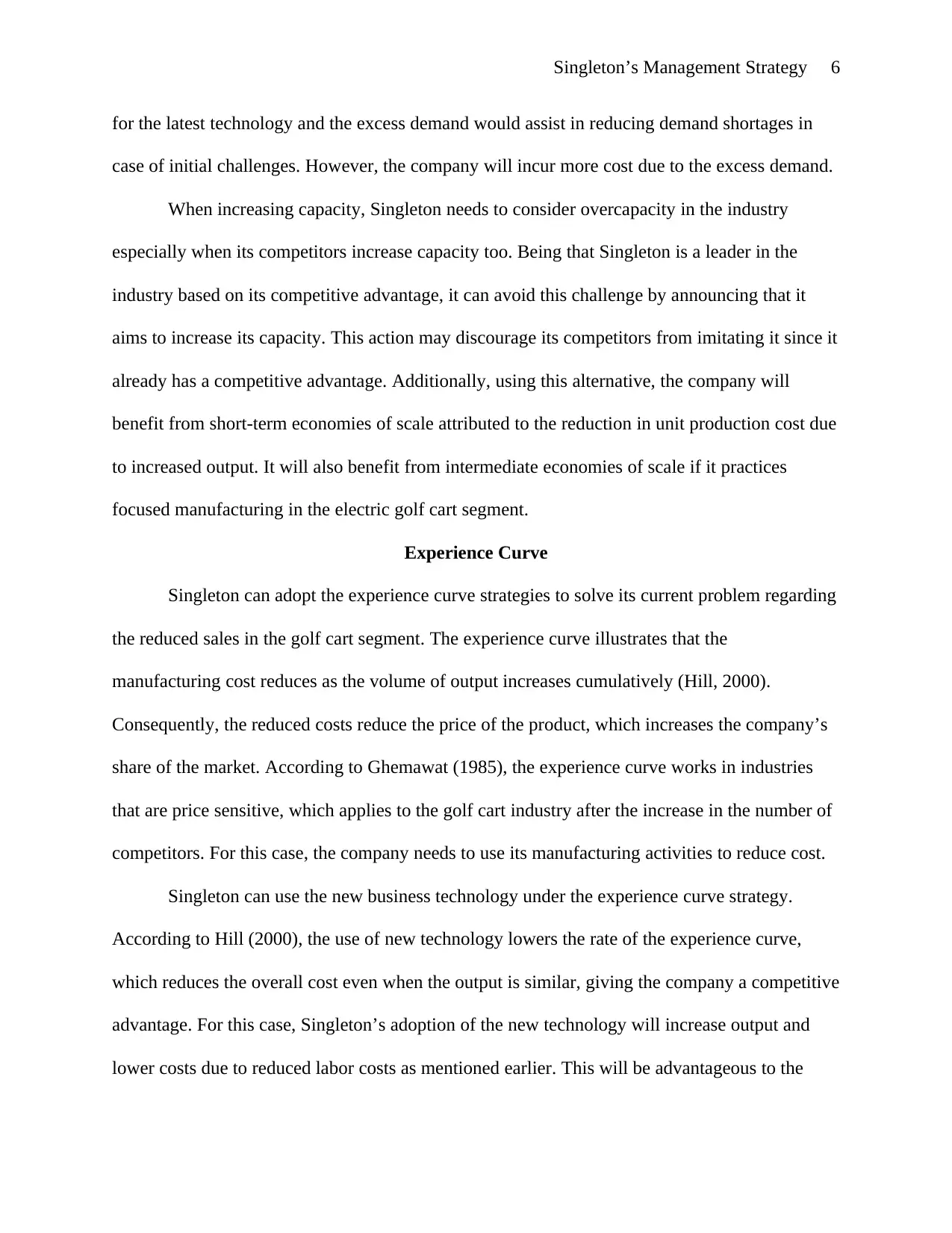
Singleton’s Management Strategy 6
for the latest technology and the excess demand would assist in reducing demand shortages in
case of initial challenges. However, the company will incur more cost due to the excess demand.
When increasing capacity, Singleton needs to consider overcapacity in the industry
especially when its competitors increase capacity too. Being that Singleton is a leader in the
industry based on its competitive advantage, it can avoid this challenge by announcing that it
aims to increase its capacity. This action may discourage its competitors from imitating it since it
already has a competitive advantage. Additionally, using this alternative, the company will
benefit from short-term economies of scale attributed to the reduction in unit production cost due
to increased output. It will also benefit from intermediate economies of scale if it practices
focused manufacturing in the electric golf cart segment.
Experience Curve
Singleton can adopt the experience curve strategies to solve its current problem regarding
the reduced sales in the golf cart segment. The experience curve illustrates that the
manufacturing cost reduces as the volume of output increases cumulatively (Hill, 2000).
Consequently, the reduced costs reduce the price of the product, which increases the company’s
share of the market. According to Ghemawat (1985), the experience curve works in industries
that are price sensitive, which applies to the golf cart industry after the increase in the number of
competitors. For this case, the company needs to use its manufacturing activities to reduce cost.
Singleton can use the new business technology under the experience curve strategy.
According to Hill (2000), the use of new technology lowers the rate of the experience curve,
which reduces the overall cost even when the output is similar, giving the company a competitive
advantage. For this case, Singleton’s adoption of the new technology will increase output and
lower costs due to reduced labor costs as mentioned earlier. This will be advantageous to the
for the latest technology and the excess demand would assist in reducing demand shortages in
case of initial challenges. However, the company will incur more cost due to the excess demand.
When increasing capacity, Singleton needs to consider overcapacity in the industry
especially when its competitors increase capacity too. Being that Singleton is a leader in the
industry based on its competitive advantage, it can avoid this challenge by announcing that it
aims to increase its capacity. This action may discourage its competitors from imitating it since it
already has a competitive advantage. Additionally, using this alternative, the company will
benefit from short-term economies of scale attributed to the reduction in unit production cost due
to increased output. It will also benefit from intermediate economies of scale if it practices
focused manufacturing in the electric golf cart segment.
Experience Curve
Singleton can adopt the experience curve strategies to solve its current problem regarding
the reduced sales in the golf cart segment. The experience curve illustrates that the
manufacturing cost reduces as the volume of output increases cumulatively (Hill, 2000).
Consequently, the reduced costs reduce the price of the product, which increases the company’s
share of the market. According to Ghemawat (1985), the experience curve works in industries
that are price sensitive, which applies to the golf cart industry after the increase in the number of
competitors. For this case, the company needs to use its manufacturing activities to reduce cost.
Singleton can use the new business technology under the experience curve strategy.
According to Hill (2000), the use of new technology lowers the rate of the experience curve,
which reduces the overall cost even when the output is similar, giving the company a competitive
advantage. For this case, Singleton’s adoption of the new technology will increase output and
lower costs due to reduced labor costs as mentioned earlier. This will be advantageous to the
⊘ This is a preview!⊘
Do you want full access?
Subscribe today to unlock all pages.

Trusted by 1+ million students worldwide
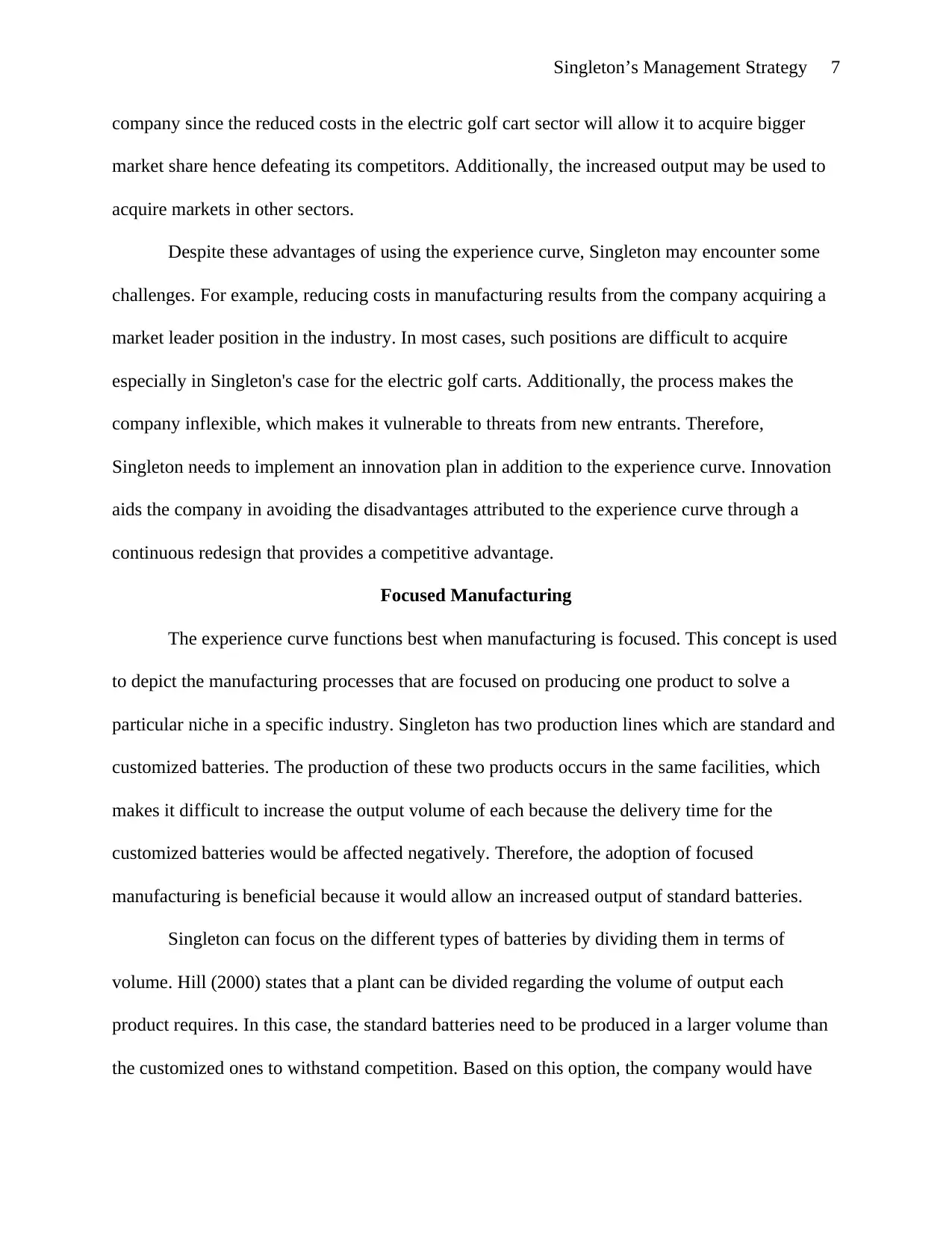
Singleton’s Management Strategy 7
company since the reduced costs in the electric golf cart sector will allow it to acquire bigger
market share hence defeating its competitors. Additionally, the increased output may be used to
acquire markets in other sectors.
Despite these advantages of using the experience curve, Singleton may encounter some
challenges. For example, reducing costs in manufacturing results from the company acquiring a
market leader position in the industry. In most cases, such positions are difficult to acquire
especially in Singleton's case for the electric golf carts. Additionally, the process makes the
company inflexible, which makes it vulnerable to threats from new entrants. Therefore,
Singleton needs to implement an innovation plan in addition to the experience curve. Innovation
aids the company in avoiding the disadvantages attributed to the experience curve through a
continuous redesign that provides a competitive advantage.
Focused Manufacturing
The experience curve functions best when manufacturing is focused. This concept is used
to depict the manufacturing processes that are focused on producing one product to solve a
particular niche in a specific industry. Singleton has two production lines which are standard and
customized batteries. The production of these two products occurs in the same facilities, which
makes it difficult to increase the output volume of each because the delivery time for the
customized batteries would be affected negatively. Therefore, the adoption of focused
manufacturing is beneficial because it would allow an increased output of standard batteries.
Singleton can focus on the different types of batteries by dividing them in terms of
volume. Hill (2000) states that a plant can be divided regarding the volume of output each
product requires. In this case, the standard batteries need to be produced in a larger volume than
the customized ones to withstand competition. Based on this option, the company would have
company since the reduced costs in the electric golf cart sector will allow it to acquire bigger
market share hence defeating its competitors. Additionally, the increased output may be used to
acquire markets in other sectors.
Despite these advantages of using the experience curve, Singleton may encounter some
challenges. For example, reducing costs in manufacturing results from the company acquiring a
market leader position in the industry. In most cases, such positions are difficult to acquire
especially in Singleton's case for the electric golf carts. Additionally, the process makes the
company inflexible, which makes it vulnerable to threats from new entrants. Therefore,
Singleton needs to implement an innovation plan in addition to the experience curve. Innovation
aids the company in avoiding the disadvantages attributed to the experience curve through a
continuous redesign that provides a competitive advantage.
Focused Manufacturing
The experience curve functions best when manufacturing is focused. This concept is used
to depict the manufacturing processes that are focused on producing one product to solve a
particular niche in a specific industry. Singleton has two production lines which are standard and
customized batteries. The production of these two products occurs in the same facilities, which
makes it difficult to increase the output volume of each because the delivery time for the
customized batteries would be affected negatively. Therefore, the adoption of focused
manufacturing is beneficial because it would allow an increased output of standard batteries.
Singleton can focus on the different types of batteries by dividing them in terms of
volume. Hill (2000) states that a plant can be divided regarding the volume of output each
product requires. In this case, the standard batteries need to be produced in a larger volume than
the customized ones to withstand competition. Based on this option, the company would have
Paraphrase This Document
Need a fresh take? Get an instant paraphrase of this document with our AI Paraphraser
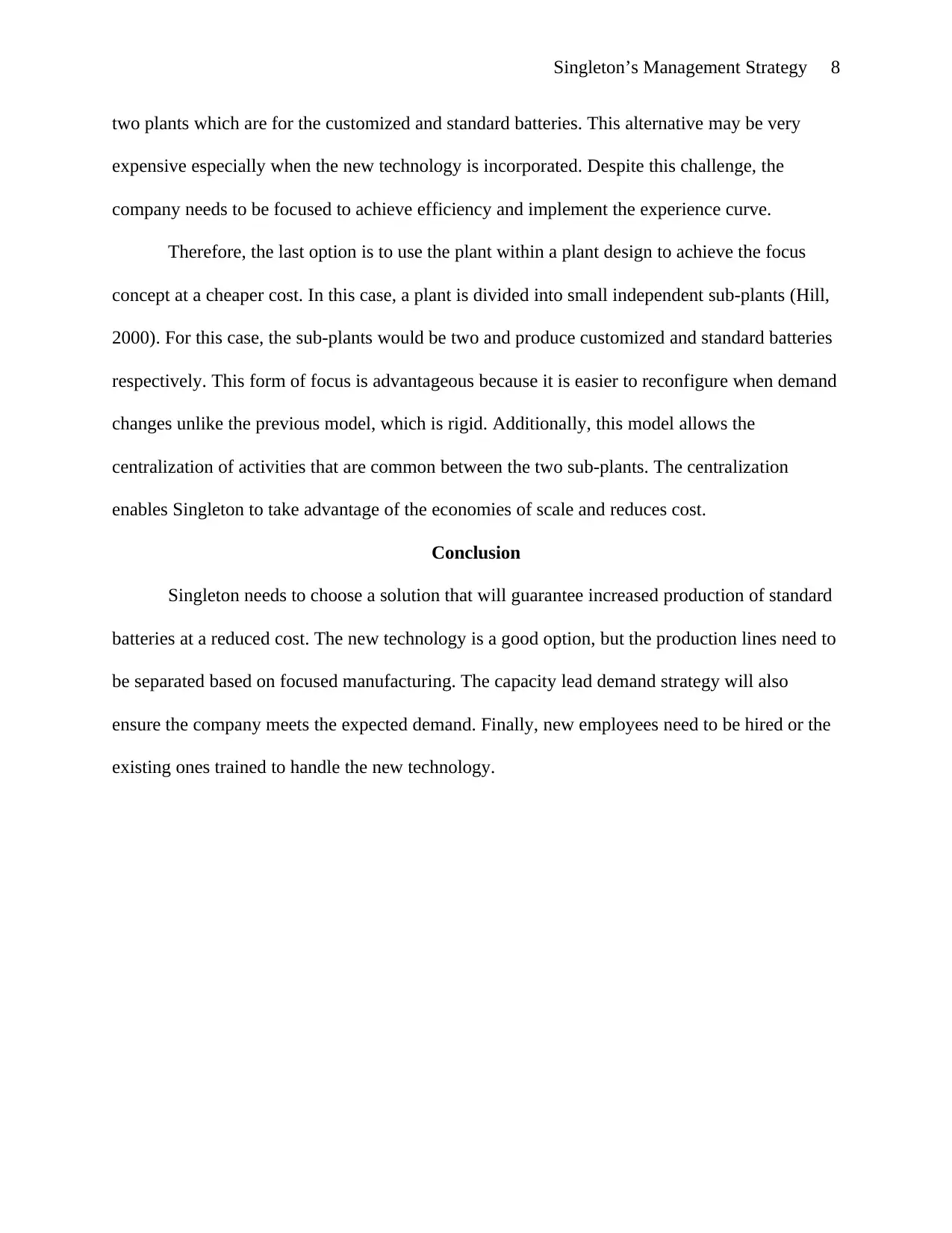
Singleton’s Management Strategy 8
two plants which are for the customized and standard batteries. This alternative may be very
expensive especially when the new technology is incorporated. Despite this challenge, the
company needs to be focused to achieve efficiency and implement the experience curve.
Therefore, the last option is to use the plant within a plant design to achieve the focus
concept at a cheaper cost. In this case, a plant is divided into small independent sub-plants (Hill,
2000). For this case, the sub-plants would be two and produce customized and standard batteries
respectively. This form of focus is advantageous because it is easier to reconfigure when demand
changes unlike the previous model, which is rigid. Additionally, this model allows the
centralization of activities that are common between the two sub-plants. The centralization
enables Singleton to take advantage of the economies of scale and reduces cost.
Conclusion
Singleton needs to choose a solution that will guarantee increased production of standard
batteries at a reduced cost. The new technology is a good option, but the production lines need to
be separated based on focused manufacturing. The capacity lead demand strategy will also
ensure the company meets the expected demand. Finally, new employees need to be hired or the
existing ones trained to handle the new technology.
two plants which are for the customized and standard batteries. This alternative may be very
expensive especially when the new technology is incorporated. Despite this challenge, the
company needs to be focused to achieve efficiency and implement the experience curve.
Therefore, the last option is to use the plant within a plant design to achieve the focus
concept at a cheaper cost. In this case, a plant is divided into small independent sub-plants (Hill,
2000). For this case, the sub-plants would be two and produce customized and standard batteries
respectively. This form of focus is advantageous because it is easier to reconfigure when demand
changes unlike the previous model, which is rigid. Additionally, this model allows the
centralization of activities that are common between the two sub-plants. The centralization
enables Singleton to take advantage of the economies of scale and reduces cost.
Conclusion
Singleton needs to choose a solution that will guarantee increased production of standard
batteries at a reduced cost. The new technology is a good option, but the production lines need to
be separated based on focused manufacturing. The capacity lead demand strategy will also
ensure the company meets the expected demand. Finally, new employees need to be hired or the
existing ones trained to handle the new technology.
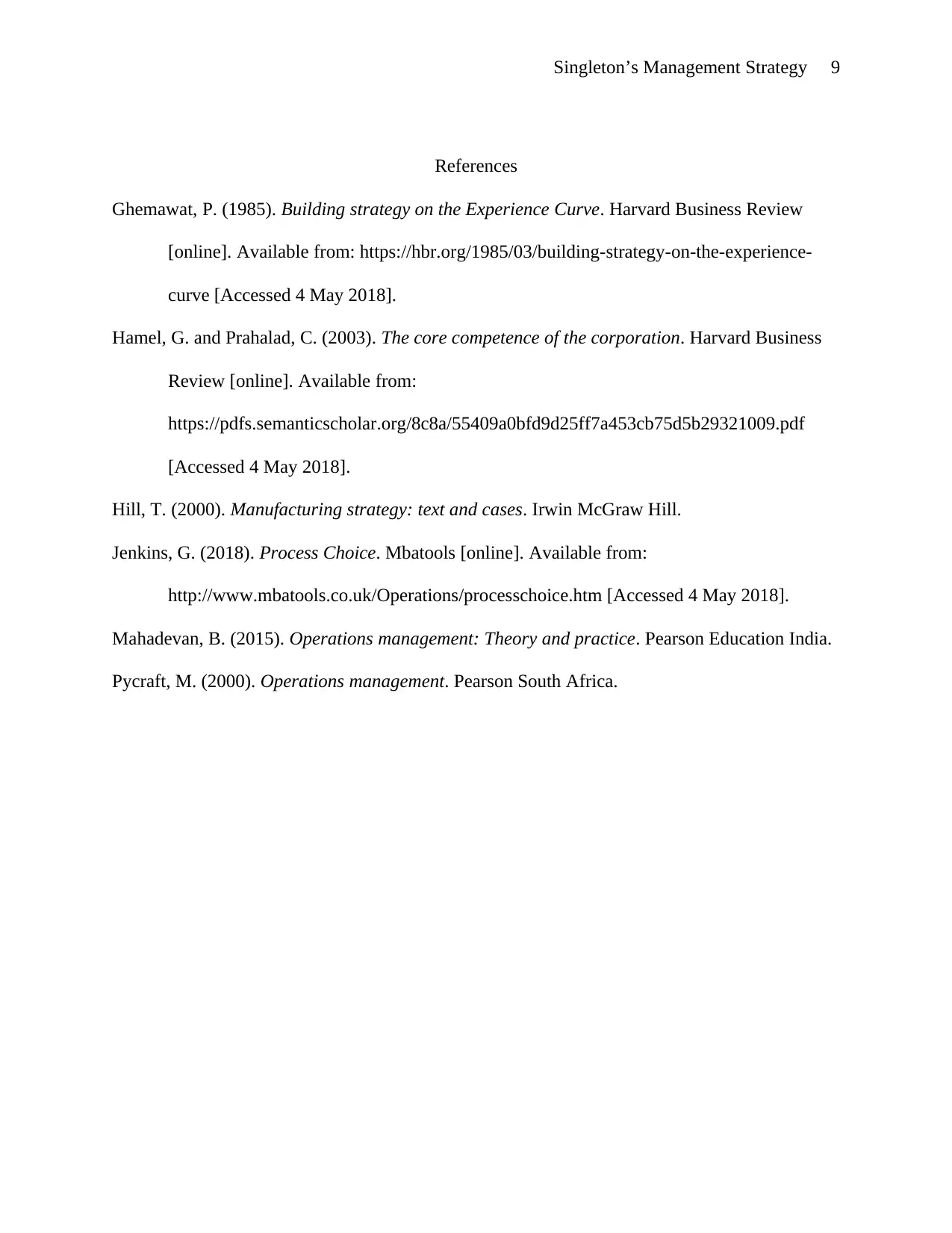
Singleton’s Management Strategy 9
References
Ghemawat, P. (1985). Building strategy on the Experience Curve. Harvard Business Review
[online]. Available from: https://hbr.org/1985/03/building-strategy-on-the-experience-
curve [Accessed 4 May 2018].
Hamel, G. and Prahalad, C. (2003). The core competence of the corporation. Harvard Business
Review [online]. Available from:
https://pdfs.semanticscholar.org/8c8a/55409a0bfd9d25ff7a453cb75d5b29321009.pdf
[Accessed 4 May 2018].
Hill, T. (2000). Manufacturing strategy: text and cases. Irwin McGraw Hill.
Jenkins, G. (2018). Process Choice. Mbatools [online]. Available from:
http://www.mbatools.co.uk/Operations/processchoice.htm [Accessed 4 May 2018].
Mahadevan, B. (2015). Operations management: Theory and practice. Pearson Education India.
Pycraft, M. (2000). Operations management. Pearson South Africa.
References
Ghemawat, P. (1985). Building strategy on the Experience Curve. Harvard Business Review
[online]. Available from: https://hbr.org/1985/03/building-strategy-on-the-experience-
curve [Accessed 4 May 2018].
Hamel, G. and Prahalad, C. (2003). The core competence of the corporation. Harvard Business
Review [online]. Available from:
https://pdfs.semanticscholar.org/8c8a/55409a0bfd9d25ff7a453cb75d5b29321009.pdf
[Accessed 4 May 2018].
Hill, T. (2000). Manufacturing strategy: text and cases. Irwin McGraw Hill.
Jenkins, G. (2018). Process Choice. Mbatools [online]. Available from:
http://www.mbatools.co.uk/Operations/processchoice.htm [Accessed 4 May 2018].
Mahadevan, B. (2015). Operations management: Theory and practice. Pearson Education India.
Pycraft, M. (2000). Operations management. Pearson South Africa.
⊘ This is a preview!⊘
Do you want full access?
Subscribe today to unlock all pages.

Trusted by 1+ million students worldwide
1 out of 9
Related Documents
Your All-in-One AI-Powered Toolkit for Academic Success.
+13062052269
info@desklib.com
Available 24*7 on WhatsApp / Email
![[object Object]](/_next/static/media/star-bottom.7253800d.svg)
Unlock your academic potential
Copyright © 2020–2025 A2Z Services. All Rights Reserved. Developed and managed by ZUCOL.





